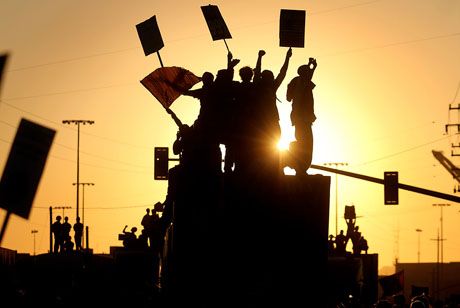News
You are here
Fracking dangerous

January 5, 2013
There is a fortune of fossil fuel underfoot, wherever a layer of shale rock forms part of the bedrock. All that is required to release the fuel–mostly natural gas–is to break up that rock layer by injecting massive amounts of pressurized fluids. The process is called hydraulic fracturing, better known as fracking. And there are potential fracking shale beds under much of North America. Along with creating billions of dollars in potential profit, more and more evidence is emerging that fracking creates a legion of environmental problems, from depleting the water table, to poisoning ground water, to causing earthquakes.
Like extracting synthetic crude from the Tar Sands, releasing gas through fracking is difficult and expensive. The method has been used on small-scale local projects for decades, but now fracking, along with increased exploitation of coal, is the centerpiece for US energy policy. US government data shows that the fossil fuel industry intends to drill more than 100 new wells this year.
Fracking uses huge amounts of water. Industry sources admit a single well may use over 5 million gallons over its lifetime. Some of the most heavily exploited fracking areas, like north Texas, are in semi-arid plains regions where the subterranean aquifer is the only water source. Though surely not the only cause, fracking contributes to the on-going drought that has plagued the US mid-west in recent years.
The fluids used in fracking are a combination of water, sand and chemicals. Energy corporations do not publicly report what chemicals they use. There are many instances where toxic wastewater has migrated back into the local aquifer, poisoning well water for entire communities.
Additionally, natural gas can be released into the water table. The documentary film “Gasland” introduced the frightening image of people being able to ignite the gas and flammable waste coming out of their kitchen taps.
Every fracking injection creates a mini-earthquake. They often trigger local fault lines to cause more serious quakes. Some areas, like Guy, Arkansas, have experienced hundreds of quakes, dubbed “swarm” quakes. Not severe enough to individually cause surface destruction–the largest Arkansas quake had a magnitude of 4.3–there is concern that buildings are being weakened and may become dangerous.
These quakes do allow gas and toxic wastewater to escape from their shale strata, into aquifers or even escaping to the surface. Health problems result from water and air pollution.
Many European countries have banned or placed temporary moratoria on fracking. In the US, communities (Pittsburgh and others) and entire states (Vermont, New Jersey) have at least temporarily halted fracking. This results from growing grassroots opposition.
Meanwhile the gas and oil industry defends the practice, and has forced a compliant federal government to exempt them from serious environmental scrutiny.
BC’s partial moratorium
On the day a moratorium on fracking in the Sacred headwaters region of British Columbia was due to expire, Shell Oil, the Province of BC and the Tahltan Central Council came to an agreement to extend the moratorium indefinitely.
On December 18, 2012 a four year moratorium on oil and gas exploration was due to expire. In 2004, Shell acquired rights to natural gas and petroleum covering over 4000 square kilometers in north west BC. This region know as the Klappan Valley or the Sacred Headwaters, is the origin of the Skeena River, Nass River and Stikine River. During that year and the next Shell drilled three exploratory wells. Opposition to the project lead Shell to stop drilling and then in 2008 to agree to a four year moratorium on exploration.
This decision by Shell to end its exploration in the area and for the Liberal government to agree to issue no future petroleum and natural-gas tenure in the area, comes due to the well organized opposition to this project as well as the still growing opposition to the Enbridge Northern Gateway Oil pipeline.
Across North America there has been rapid growth in natural gas drilling, so much so that the price has dropped and as a consequence the number of new wells being drilled has also declined.
It is this combination of the determined and spreading opposition to the Enbridge pipeline and the lowering gas prices that drove Shell out of the Sacred Headwaters.
The ban does not extend to other shale-bearing areas of BC, and the province and fossil fuel industry still plan to use fracking to release gas, to be liquified and shipped to Asian markets by supertankers.
Section:
- Log in to post comments










